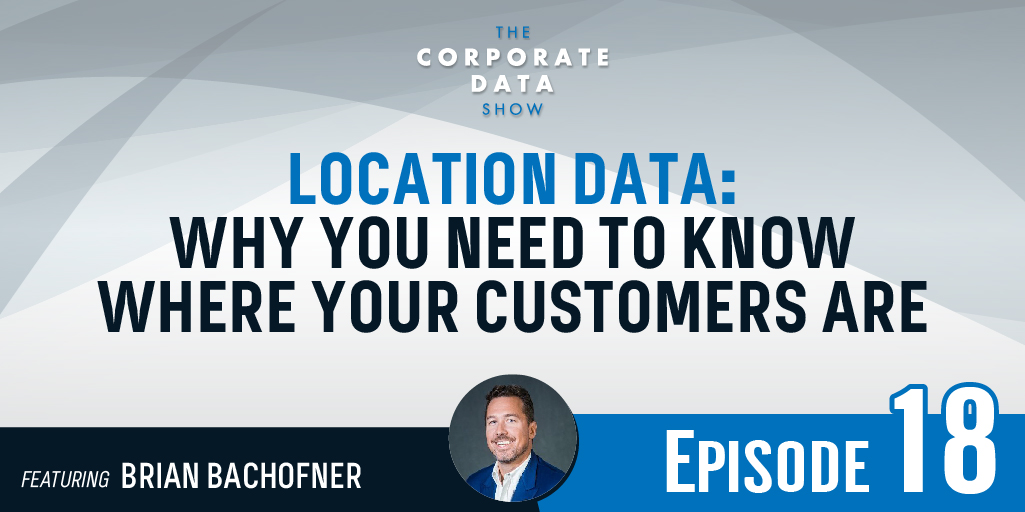
MapAnything deals with location data, letting you know where your customers/prospects are.
It’s a different kind of data topic than we’re used to covering on The...
Not too long ago, I had the pleasure of sitting down on the Corporate Data Show with Sushant Bhardwaj to discuss what he does at Safegraph, specifically when it comes to the company’s involvement in Placekey. For those of you that didn’t tune in, Safegraph is a reseller of B2B data, a lot like us here at EMM, and Placekey is a free platform focusing on geospatial data.
Sushant and his colleagues are dedicated to making this geospatial data tool freely available to all of us dealing with big data. It may not sound like a huge deal, but this is actually a very noble cause, as geospatial data is crucial to everything we do as marketers.
Whether you realize it or not, you’re most likely using it everyday, and it’s only going to become more important as the industry progresses, so I thought we should discuss it more in-depth.
Geospatial data is a fancy term that pretty much refers to any type of location-based data. As Sushant puts it when discussing his work with Safegraph and Placekey, the collection of geospatial data is essentially an effort to “collect facts about the physical world.”
This could cover a whole slew of things, such as GPS coordinates of businesses, whether or not they have parking lots, neighboring businesses, foot traffic through the area, and more.
Of course, the most commonplace use for geospatial data is in mapmaking and GPS devices. We’ve all used something like Garmin, Apple Maps, or Google Maps, even for places that we’ve been to 13 times (it’s okay, you can admit it).
This use is important for businesses, at least brick and mortar ones, because it allows consumers to find them. However, geospatial data’s usefulness in marketing goes much deeper than this, particularly when it comes to segmentation by demographics.
Marketers and data professionals know segmentation like it’s their job (because it is). Essentially, it’s taking a larger population and refining it down into segments that are useful for a particular purpose. People like email marketers and advertising professionals do this all the time when they’re selecting their target audience for a campaign.
For example, imagine you’re in charge of social media marketing efforts for a vegan snack brand. Your primary customer persona describes a middle-class mother with young children. She cares about their nutrition, but is too busy working and driving them to school and football practice to prepare healthy snacks.
Using segmentation, you can reach women who fit this exact description and push ads based on their provided age on social media, maternal or marital status, search history (maybe they’ve Googled something like “healthy kids’ snacks”), household income, and even their geographic location.
Simply put, the demographics for the citizens in one area will likely differ from another - and in some cases, it can be very drastic. US News reported that 83% of the residents in Irvine, California have exercised in the last 30 days, and 25.4% have met the guidelines set by the American College of Sports Medicine and Centers for Disease Control and Prevention.
And an article by USA Today stated that in California-Lexington Park, Maryland, 24.8% of workers are in STEM fields and the median wage for those individuals is $102,826 with the most common STEM job in aerospace engineering.
These facts based on geographic locations, like states, cities, zip codes, and entire regions can be used by marketing and data professionals to pin-point the exact target audience they’re looking for. A very simple source of this demographic-based information is the U.S. Census Bureau. Using their tool and other tools like it, you can learn the total population, age, sex, ethnicity, marital status, income, education, jobs, interest categories, and much more.
Not only can marketing and data professionals look at the demographics of an area’s residents, they can look at the facts about states and cities that allow for safe assumptions to be made for products or service solutions those residents might be looking for.
Phoenix, Arizona topped the list as the hottest city in America. Conversely, Fairbanks, Alaska has been labeled the coldest city in the U.S. with an average snowfall of 60.9 inches every year. People living in the Phoenix area are likely looking for household solutions to keep themselves cool and the residents of Fairbanks are probably purchasing winter apparel and opt for purchasing more vehicles with four-wheel drive.
Just as the phrase says, “birds of a feather flock together,” people of similar demographics will likely live close to one another. In addition, facts about particular areas on the earth’s surface (like location, climate, and weather) can also help paint a clear picture of the type of people that live there, what they like to do, and what they like to buy.
Sales, marketing, and data professionals can leverage these trends to help drive growth for both their clients and themselves.
None of these aspects of geospatial B2B data are new in the marketing world, but they are becoming more and more important in the digital age. Prior to digital marketing, it was still important to know who your target audience was and where they lived, so you could broadcast ads on the right television channels or in the right newspapers.
This was all fine and good, but now, we have the ability to segment our audiences down to the person. We can serve ads to single users depending on their location, web usage, and more.
So, the more online our society becomes, the more important geospatial data becomes.
I briefly covered some of the uses and benefits of geospatial data for businesses already, but it’s perhaps best exemplified in a real-world scenario.
Let’s say you’re a clothing retailer planning to expand your business into new markets. First, you need to select the markets you want to move into, meaning you need access to demographic data for any city you’re considering to see if its residents fit the bill for your customer persona.
After this, you need to select a physical location within that market, which will depend on many factors: How much foot traffic does the storefront get? How wealthy are the residents in surrounding neighborhoods? Is there a parking lot or room to build one? The list goes on and on.
Once you’ve done all of this, you’ll serve ads to the appropriate people within a certain radius of your store, and advertise in the appropriate papers and on highly visible billboards, etc. And then you’ll want to make the geospatial data concerning your new store available so that you appear in searches, on maps, and in databases, helping you gain visibility.
Even this somewhat involved scenario is a very simplified version of the actual process a business owner would go through, but you get the picture: geospatial data comes into play in every part of the process.
Of course, most of you reading this aren’t clothing retailers. You’re B2B data and B2C data buyers and resellers, or marketing and sales professionals. However, seeing as geospatial is this important to business owners, it’s just as important to you, because those business owners are your potential clients. Thus, a thorough understanding and extensive database of geospatial data is crucial to your success, as well.
This is where Placekey comes in. Some really awesome people out there, including Sushant and his colleagues at Safegraph, have been multiple steps ahead of us for some time now, and have begun compiling massive amounts of geospatial and physical data into a database. As if this wasn’t cool enough, they’ve also made it free to access.
Very few things come free in this industry, so it’s truly amazing that all the folks working on this initiative are making it happen. Furthermore, it should speak even further to how crucial this info really is.
The best part about Placekey, though (yes, even better than it being free), is that it standardizes and organizes geospatial data in a way it never has been before. If you’ve ever bought geospatial data, or really any kind of data, you know that a huge issue is lack of standardization.
Some providers might give you only 5-digit zip codes while others give full ones. Some latitudes and longitudes will be listed with decimals while others are done with dashes. Perhaps some addresses are listed with European convention rather than American. Whatever the issue, it’s frustrating and makes it harder for you to do your job.
Placekey is eliminating these discrepancies by creating one uniform way of compiling and displaying geospatial datasets, which is surely going to make all of our lives easier moving forward.
As we become an even more technologically advanced society, geospatial and physical data will continue to become even more important. As I mentioned before, the emergence of digital marketing has already made geospatial data much more relevant. So, it would logically follow that as digital marketing becomes even more mature and widespread, so too will the use of geospatial data.
It’s hard to truly make predictions of what we have in store without sounding Black Mirror-esque, but ad targeting based on geospatial data is only going to become more and more prevalent.
You know how you get served 20 ads regarding corduroy pants minutes after you complimented your friend’s at dinner? Well, think that but based on where you (or rather, your cell phone) have been, where you reside, and what community affiliations you have.
You’ll get served ads for businesses in the area that align with this data, at the time they would best serve you, in a way that makes it seem like the most convenient option for you right at that second. If you’re paying attention, this is happening already, but it’s certainly going to start happening more often with more sophistication.
This is why many data resellers and marketing agencies alike are beginning to seek out employees who have expertise not just in sales or marketing, but also in geographic info systems and geospatial data.
Every Market Media already offers a great deal of geospatial data attributes within our B2B and B2C databases that allows marketers to do everything we just talked about but to increase the value of our product offering, look out as we integrate Placekey into our data. For more information there, be sure to review our current data products. On each product page, you’ll find our data dictionaries outlining all the attributes and fields that we offer.
If you’d like to learn more about what Placekey is doing, you can do so at Placekey.io. You can even try out their software and access some geospatial data for yourself, if you’d like. Either way, we're looking forward to adding Placekey to our product offering soon.
Until then, check out our U.S. and global business executive email databases for any postal addresses or company data you might need. We're proudly one of the strongest database providers in the industry, supplying access to our email databases to some of the biggest players in the game - and we're planning on keeping it that way.
Regardless, be on the lookout for geospatial data to become more and more important as time goes on, and be sure to keep up to date on it, because it will most definitely affect your daily lives in the near future.

MapAnything deals with location data, letting you know where your customers/prospects are.
It’s a different kind of data topic than we’re used to covering on The...

The goal for any marketer is to focus on efficient and effective marketing campaigns that produce results. For outbound marketers, that means aggregating data well to...